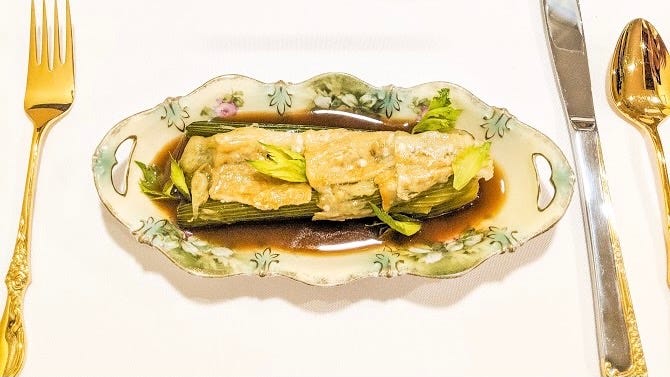Brown’s take seems to square with other, more withering, takes on sherry’s demise—none more vicious than this pre-pandemic assessment by Don Kavanagh in Wine-Searcher:
Extinction is such a final word that it seems strange to use in terms of an entire category of wine, but along with gorillas, the Sumatran elephant, and the white rhino we may soon have to add the name Sherry.
That epitome of genteel elegance, the go-to wine for both maiden aunts and hairy faced hipster sommeliers would appear to be in the final waiting room, as it were, its loving, but exhausted family sitting by the bed wondering if this will finally the moment when a beloved but long-ailing family member breathes its last. “It would be a mercy,” they mutter to each other, unable to watch another rattling breath. “It's a kindness in the long run.”….
Sommeliers and “wine educators” might still trumpet Sherry’s charms to the wider world, but it will fall on deaf ears. The real interest in the wines might well be limited to whisky distillers who need the barrels to age their own product, but the general public’s interest will gradually shrink. And that great Sherry revival? Stick a fork in it, it’s done.
Yikes. To be clear, I am a sherry lover. Last spring, Juice Box Beth and I took a deep dive into sherry on the Everyday Drinking podcast (Will there be a Season 2? Who knows?)
Beth even wrote a piece entitled “Why Sherry (and Old Love) Makes Me Sad.” We worry about sherry’s future — especially after the failure of the so-called “sherry renaissance” pushed so hard by the so-called “hairy-faced hipster sommeliers” over the past decade.
When people talk about sherry, I’m oddly reminded of celery. Specifically, I think about the celery served at Elwood, one of my favorite restaurants in Philadelphia, honestly one of the most unique and essential spots anywhere. Chef Adam Diltz is known for unearthing and reinventing historic dishes—catfish-and-waffles, snapper soup, bullfrog fricassee, ham pot pie—that were famous in Philadelphia during the early 19th century, when it was a culinary capital and the second-largest English-speaking city in the world. (Check out my profile of Diltz and Elwood to find out, among other bits of food history, why “chicken and waffles” isn’t actually “southern” at all).
The celery is perhaps my favorite item on Elwood’s menu: whole celery heart, slowly braised in stock and sherry, oozing with local Pennsylvania cheese, and served in an ornate turn-of-the-century celery dish.
Yes, at one time in history, celery was so prized that it demanded its own dish. “During the Victorian era, celery was the hottest dish to eat. It was difficult to grow and so it was a status symbol.” says Diltz, who spent years acquiring a collection of antique dinnerware for his restaurant. “Celery dishes were once someone’s prized possession and now no one cares about them.”
Who among us can even imagine a time when celery was the avocado toast of its day? “That’s why I do that dish,” Diltz says. “Plus, I love celery and no one else does.” If this last bit is true, that could change after eating his version, channeling the 19th century, which just might make anyone fall deeply in love with celery.
But back to the original idea: Why does celery make me think about sherry? On the most basic level, it’s because sherry (and Madeira) pop up as ingredients over and over again on Diltz’s menu (even though Elwood is BYOB, another Philly quirk). Not just in the braised celery sauce. Classic snapper soup, for instance, is always served with sherry (spiked with peppers).
More importantly, it’s because sherry (and other fortified wines) had their heyday during the same era when celery was a trendy, of-the-moment vegetable. My suggestion to those people trying to make sherry happen is to channel Chef Diltz: Embrace the old and historic deeply, but also meet people where they are. Whether that’s in Philadelphia or elsewhere.
I’m going to be visiting sherry producers in Jerez de la Frontera and Sanlucar de Barrameda in a few weeks, and so our conversation about sherry in Everyday Drinking will be ongoing. We’re going to explore en rama sherries and single cask bottlings, and the exciting still wines from the region, and all the new stuff. Stay tuned.
But for now, I want to recommend two things. First, PM Spirits has released a series of exquisite cask-selection sherries, in partnership with cult producer Equipo Navazos. They’re not as cheap as your old Tio Pepe, but if you like sherry and haven’t tried them yet, run don’t walk.
Next, I recommend popping open a bottle of amontillado and enjoying it with Elwood’s braised celery recipe below. Close your eyes. Imagine it’s 1800. Dream you’re in Philadelphia. Pretend it’s the most important city in the world.
Braised Celery
This deliciousness of this dish, from Adam Diltz at Elwood, might shock you. This recipes serves 2-4 people depending on whether this is a side or main dish.
2 celery hearts, washed
2 quarts chicken stock
1 cup sherry or Madeira
6 oz. aged Gouda, grated (Diltz uses Goat Rodeo Hootenanny)
6 oz. hard Alpine cheese such as gruyère, or Prima Donna, shaved thin (Diltz uses Clover Creek’s Royer Mountain)
½ cup butter
½ cup flour
Cover the celery hearts with the stock and wine and cover tightly. Place in a 350F oven and cook until the celery is tender, about 40-45 minutes. Cook until tender but not too long so it gets too soft. Remove celery hearts, saving the stock.
Make a roux with the butter and flour and add stock. Simmer and reduce until it is slightly thickened.
Open the celery up with a knife and sprinkle grated aged Gouda (or other) cheese inside. Place shaved gruyère (or other) on top. Place celery in the oven and let the cheese melt and brown. To serve, place celery on plate and spoon sauce around it.









